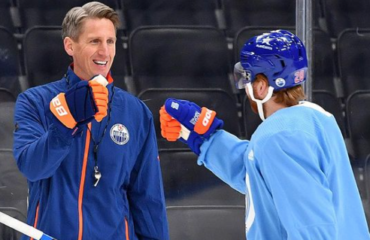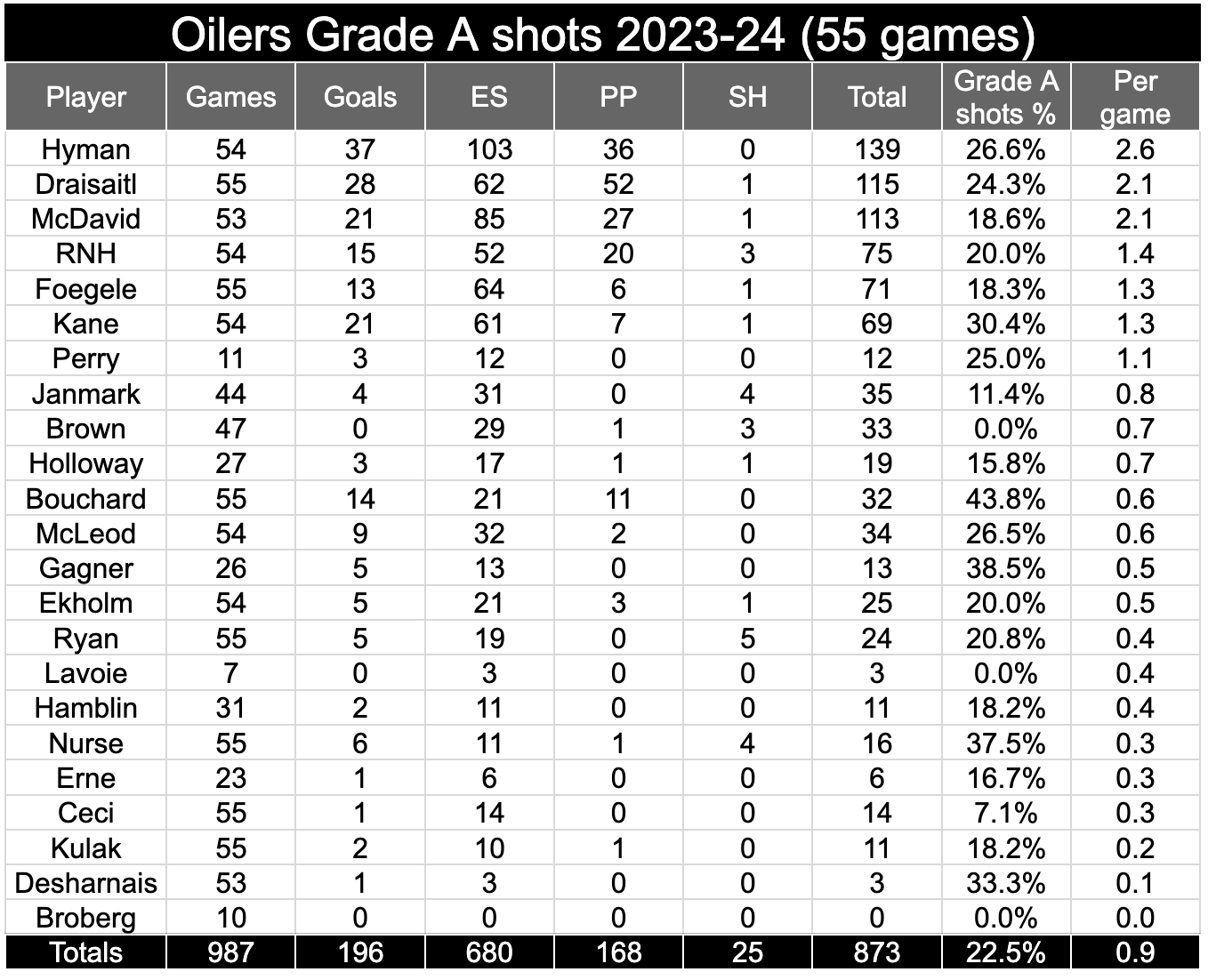Mark Spector, writing for Sportsnet, commented on Connor McDavid’s decreased scoring rate this season in his column following the Edmonton Oilers’ 6-3 loss to the Calgary Flames on Saturday night. Spector noted that while McDavid is widely regarded as the best player in the world, criticisms of his game have become rare. However, he raised concerns about McDavid frequently opting to pass instead of shooting when in prime scoring positions, despite being a prolific 64-goal scorer last season. Spector pointed out McDavid’s recent nine-game goal drought as evidence of this trend.
/cdn.vox-cdn.com/uploads/chorus_asset/file/22666447/1320718286.jpg)
During the post-game press conference, TSN’s Ryan Rishaug questioned Oilers coach Kris Knoblauch about McDavid’s scoring slump. Knoblauch admitted he couldn’t pinpoint the exact reason for it and suggested that while McDavid has had some opportunities to shoot, he may have chosen to pass instead. However, Knoblauch didn’t believe this happened frequently enough to fully explain the drought.
My take
1. Spector isn’t alone in questioning McDavid’s recent goal-scoring drought for the Edmonton Oilers, nor is he the sole voice pondering whether McDavid’s emphasis on passing might be excessive. Nearly every pundit covering the team, along with a majority of fans, shares these concerns. How can a player who dominated the goal-scoring charts last year with 64 goals in 82 games see such a sharp decline this year, managing only 21 goals in 53 games?
2. After conducting a detailed video analysis of McDavid’s goal-scoring patterns, I find myself even more perplexed by his current performance. Consider this: despite the widespread calls from fans urging him to shoot more, McDavid’s shot attempts this season are nearly identical to last year’s figures. Last season, he averaged 6.5 shots on goal per game, resulting in 0.78 goals per game. This year, he’s maintaining a rate of 6.3 shots per game but scoring only 0.40 goals per game. The disparity between his shot attempts and goal production is striking; it’s evident that he is indeed taking shots.
3. Moreover, when we examine McDavid’s overall impact on generating high-quality scoring opportunities, he’s consistently performing at a level comparable to his stellar 2022-23 season. Last year, he averaged 6.9 significant contributions to Grade A scoring chances per game, tallying 153 points in 82 games, equating to 1.87 points per game, his second-highest rate for a season. This year, he’s maintaining an average of 6.8 significant contributions to Grade A scoring chances per game, amassing 89 points in 53 games, resulting in 1.68 points per game, his third-highest rate for a season. McDavid remains a dominant force in offensive play, boasting the highest points-per-game rate among top NHL forwards. Despite facing challenges such as injury earlier this year, he’s on track to secure another NHL scoring title and has been steadily climbing the leaderboard.
“Alright, so McDavid is directing the puck towards the net at a similar rate as last season and he’s creating opportunities for high-quality shots through both his passes and shots, also at a comparable frequency to last season. However, there’s a significant difference in his shooting performance this year compared to last year, aside from just the conversion rate. This year, the quality of his shots is lower.
While he’s still getting shots on net, a greater proportion of them are missing the target, more are being blocked by defenders, fewer qualify as Grade A shots, and there’s a reduction in the most dangerous type of shots, the ‘5-alarm’ shots as identified through video analysis at the Cult of Hockey.
Last season, he averaged 1.1 missed shots per game, but this has increased to 1.3 this year. Shots blocked per game have risen from 1.2 to 1.6, while shots on net have decreased from 4.3 to 3.3 per game.
Of particular importance, he averaged 3.1 Grade A shots per game last season, leading the Oilers in this category. However, this season, he’s down to just 2.1 per game.
Most significantly, he averaged 1.5 5-alarm shots per game last season, whereas this year it’s just 0.9 per game.
Grade A shots typically have a conversion rate of around 25%, with the subset of 5-alarm shots having an even higher conversion rate of about 33%.”
The primary question arises: Why has there been such a noticeable decline in the quality of McDavid’s shots?
I propose two theories.
Firstly, it’s possible that McDavid is dealing with an injury that allows him to skate and pass at his usual level but affects his shooting ability, resulting in less powerful shots compared to last year. Observationally, it seems that he isn’t unleashing his wrist shots with the same ferocity as before, especially when he used to consistently blast them past goalies while charging down the wing or maneuvering into prime scoring areas. It’s feasible that an injury is hindering his ability to unleash his shots with the same force as he did previously.
McDavid has denied sustaining any significant injuries, but it’s logical to consider that neither he nor his coach would publicly disclose such information, as it offers no strategic advantage and could potentially provide opponents with useful insights or offer McDavid an excuse for any performance dips.
My second theory revolves around the possibility that opposing teams have studied how Vegas defended against McDavid in last year’s playoffs and have adjusted their defensive strategies accordingly. It’s plausible that teams are now employing a more conservative defensive approach, congesting the slot and employing zone defense to thwart McDavid’s attempts to penetrate and take high-quality shots. This defensive adjustment could explain the decrease in McDavid’s breakaway opportunities compared to last year.
It’s conceivable that teams are intentionally playing defensively cautious hockey when McDavid is on the ice, and Knoblauch, the coach, may be cognizant of this shift in tactics. However, openly acknowledging the effectiveness of opponents’ strategies would not serve any strategic purpose and could potentially reinforce those tactics.
Alternatively, it’s conceivable that McDavid is not injured, and there hasn’t been a significant change in defensive tactics compared to last year, leaving Knoblauch genuinely perplexed about the situation. In this scenario, his admission of uncertainty is commendable, reflecting a willingness to acknowledge unknown factors rather than feigning certainty.
While theories abound, uncertainty persists. Knoblauch likely has his own hypotheses and insider knowledge regarding any potential injuries, but his willingness to embrace uncertainty rather than projecting an aura of omniscience is admirable.
Ultimately, if McDavid and Knoblauch are to address the issue of McDavid’s diminished scoring, it will likely require their own efforts, including diligent work, reflection, and potentially adopting new tactics. When tangible improvements occur, it will be evident, but expecting instant results or simplistic solutions overlooks the complexities involved.
Given McDavid’s talent and determination, it’s reasonable to anticipate that solutions will emerge over time, but they will likely be the result of careful analysis and hard work rather than quick fixes or external pressure.






